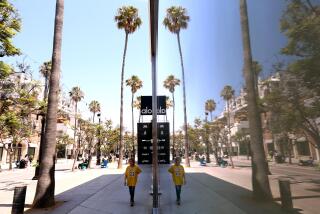Group Seeks to Restore Movie Palace District
Hoping to nurture a revival in Los Angelesâ historic core, preservationists announced a wide-ranging effort Friday to bring night life, entertainment and residents back to downtownâs once-thriving movie palace district.
The Los Angeles Conservancy, best known for its battles to halt destruction of architectural landmarks, says that it will take the lead in luring private investment to several blocks of Broadway, once the cityâs preeminent gathering spot.
Borrowing a page from the successful rejuvenation of New Yorkâs Times Square, the preservationists have identified old but less significant buildings that can be cleared away for new development--possibly even a multiplex theater.
Onstage in the opulent and cavernous 2,200-seat Orpheum Theater, conservancy Executive Director Linda Dishman told reporters her group is âstepping out of its traditional roleâ because economic regeneration is the only way to save the theater district. With a dozen huge movie houses built between 1911 and 1931 in a six-block area, Broadway is home of the nationâs largest historic theater district.
The district began its long decline after World War II, losing customers to newer suburban development.
These days, Broadway remains a daytime and weekend shopping mecca. But, with most upstairs building space vacant, and only a few theaters still operating, the corridor is transformed into a grim, empty canyon after dark.
Such publicly assisted projects as the Bradbury Building restoration and the multimillion-dollar refurbishment of the Grand Central Market have failed to ignite the downtown rebirth that public officials have long hoped for.
The preservation group insists that its effort will be different.
âThis is not just a plan thatâs going to be sitting on a shelf and be forgotten by some government agency,â said Ken Bernstein, the conservancyâs preservation director. âThis organization is going to remain active and engaged as a catalyst and leader on Broadway for years.â
A $100,000 grant from the Andy Warhol Foundation will be used to jump-start the effort, including hiring a full-time coordinator to reach out to developers, art schools, colleges and landowners to find new uses for the old theaters, as well as the neighborhoodâs vacant building space.
The plan envisions renovating the movie houses for theatrical productions, nightclubs, concerts and special film showings. Art and architecture schools are being courted to establish campus extensions in the district. Building spaces are being identified for conversion to rental lofts.
Success of the plans rests, in part, on luring a critical mass of several thousand residents to the neighborhood over the next 10 years.
Conservancy members hope to work with city officials and lenders to create a more diverse mix of restaurants and retail shops. They have plans for better lighting and more parking, as well as street and landscape improvements.
Officials say that they are not looking to gentrify the district, which caters to a largely working-class Latino clientele.
Dishman noted that the heavy daytime foot traffic on Broadway commands relatively high storefront rents. She said that is likely to ensure that many current shops will remain.
But some changes are likely if the plan goes as outlined.
New loft space, for example, will be marketed to young urban professionals, students, artists and operators of home-based businesses.
The conservancy is not alone in the effort.
Tokai Bank has committed $10 million to a loan pool for projects in the neighborhood. New city ordinances have lowered barriers to loft developments in older structures. Pending state legislation would give developers tax incentives to invest in the corridor.
With a new state office building in the rehabilitated Broadway Department Store and a proposed 250-unit housing and retail project ready to start construction nearby, the preservationists say the timing for a Broadway revival appears right.
Indeed, on Wednesday night the conservancy was expecting a capacity crowd in the Orpheum, built in 1926 as a vaudeville theater. The event is part of a six-week classic movie festival that now draws some 10,000 theatergoers to the movie houses.
New York architect Stephen Johnson, who heads a conservancy task force on the project, said the package of incentives and emphasis on regenerating a historic entertainment district has worked in one urban center after another.
âWhy not Broadway next?â he said.
(BEGIN TEXT OF INFOBOX / INFOGRAPHIC)
Reviving Downtown Theaters
The Los Angeles Conservancy has announced plans to draw new private investment and the the arts to a swath of Broadway in hopes of revitalizing part of downtown Los Angeles. The theaters listed are the largest concentration of historic movie palaces in the nation. The conservancy is hoping to bring live entertainment and other activities to many of them.
1. Million Dollar
2. Roxie
3. Cameo
4. Arcade
5. Los Angeles
6. Palace
7. State
8. Globe
9. Tower
10. Rialto
11. Orpheum
12. United Artists
More to Read
The biggest entertainment stories
Get our big stories about Hollywood, film, television, music, arts, culture and more right in your inbox as soon as they publish.
You may occasionally receive promotional content from the Los Angeles Times.










